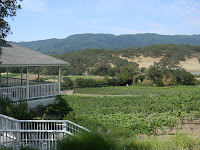With days winding down in my stay in Napa, I finally found time to make a day trip over the mountains to see what I could sip in Sonoma. Although they share a relatively similar location, Napa and Sonoma couldn't be any different. Where Napa gets all the attention for its big wines, big estates, and big prices, the subtle and subdued character of Sonoma is reflect both in its wineries and wine styles.
It is also incredible to see the difference a mountain ridge can mean in terms of climate and geography. While Sonoma does not experience the rolling fogs to the same degree as Napa, Sonoma is closer to the water so the temperatures are much more moderated. You can feel the cooler, slightly more humid air as soon as you enter the valley from Carneros. Nor does driving north see the significant heat increase as much as it does in Napa. Instead, undulating hills studded with lush forest keep things a little cooler...and a little more of a rustic country look.
I like to think that this rusticity lends itself to the more elegant, restrained style of Sonoma wines. It's also more pleasant cruising when you have a convertible at your disposal, winding your way down twisting roads. In some areas, vineyards hide amid the dense vegetation to the point that you would hardly believe you are even in Wine Country.
But I assure you it is indeed Wine Country, and a much bigger country than I had expected for just one day's drive. Pressed for time, for me it was more about hitting as many of the AVAs as possible, with a couple of signature sips along the way:
Sonoma Valley AVA
The "Napa"-iest of the County, Sonoma Valley has a stretch of cellar doors within an easy day-trip from San Francisco. Here, most wineries source their wines from vineyards throughout the County, offering a combination of Cabernets, Zinfandel, Sauvignon Blanc, and Chardonnay. Some favs include:
Kunde (www.kunde.com) - family owned for 5 generations, Kunde offers great value for old vine Zinfandel and Cabernet that would easily be double the price in Napa. Also a really neat cellar built into the hill and a working winery behind the glass windows of the tasting room;
Rolling Hills of Sonoma at Arrowood
Arrowood (www.arrowoodvineyards.com) - small production, but outstanding quality is achieved at this top-tier Sonoma Winery. Quietly owned by the Kendall-Jackson group, Arrowood still sources and produces their wines on-site, achieving best results with their Cabernet programme;
Benzinger (www.benzinger.com) - a small, sloping parking lot belies Benzinger as must-see destination when visiting Sonoma; I was surprised to see a 30-seater people-mover tram driving through the Biodynamic vineyards. All of Benzinger's grapes are certified "green" (ie. biodynamic, organic, or sustainable), and always yield good quality results. A nice surprise for a big name;
Bennett Valley AVA Oenophile "tree-house" at Matanzas Creek
The youngest of Sonoma's AVAs (proud member since 2003), Bennett Valley is also among the smallest. Nestled between Sonoma Valley, Mountain, and Coast AVAs, Bennett Valley offers a unique cool microclimate and topography that sets it apart from its bigger neighbours.
Matanzas Creek (www.matanzascreek.com) - the big name in Bennett Valley, Matanzas Creek still maintains a low-key image. Set on a slope behind a giant oak, it has more of an oenophile tree-house feel; the Sauvignon Blanc is what to look for here, but cool Chardonnay and Syrah are also very good.
Russian River AVA
Yes...there IS a Russian River...A surprisingly unpatriotic name for an American Viticultural Area, the Russian River is most famous for its Pinot Noir. Close to the coast but more inland than Carneros, elegant Pinots are what bring visitors to the area. Also, the area is among the most scenic I've been to, with wineries cloistered behind verdant hills and the winding Russian River. Try:
Gary Farrell (www.garyfarrellwines.com) - there may not be a vineyard on the property, but the stunning view alone is worth the drive. If the incredibly well-balanced Pinot Noirs aren't enough, the Chardonnay programme is among the best in Sonoma;
Thomas George (www.thomasgeorgeestates.com) - Another unassuming find along a river road, Thomas George has a very small production by California standards - only 8,000 cases - but absolutely quality driven. The Chardonnay and Pinot Noir are classic Russian River, but the Zinfandel stands out as a more elegant style than what you'd expect from California;
Dry Creek AVA
It is amazing to see the relatively rapid change from the sloping, forested Russian River to the (relatively) flat, wide, and much hotter Dry Creek. Here, fuller bodied reds do much better, and it is to Zinfandel that Dry Creek owes its fame. For the record, water flows through Dry Creek all year...:
Dry Creek Vineyard (www.drycreekvineyard.com) - Another fantastic find where the reputation is big, but the quality is even bigger. Old vine Zinfandels are a specialty, showing great diversity of expression among the single-vineyard labels. The unique Chenin Blanc is also a must sip;
Dutcher Crossing (www.dutchercrossingvineyard.com) - Boutique by anyone's standards, only a few hundred cases of each label are produced here. In the kingdom of Zinfandel, the elegant Chardonnays and beautiful Cabernets are among the best in the state. Best join the Wine Club, however, as most of the labels sell out fast.
And that is just half of my sipping from zipping around Sonoma for 8 hours. Distances between each AVA (and in some cases, wineries - Matanzas Creek is quite isolated, for example) is big, which I find to be Sonoma's curse and blessing. Hard to take in a lot in just one day, but what you find is for the most part well worth the trip. Next time, I would definitely spend more time exploring the wines of Sonoma; so much to see, so much to sip, so much Sonoma to take in!














